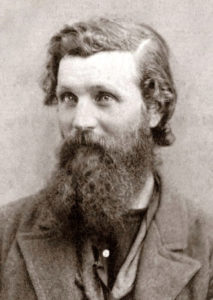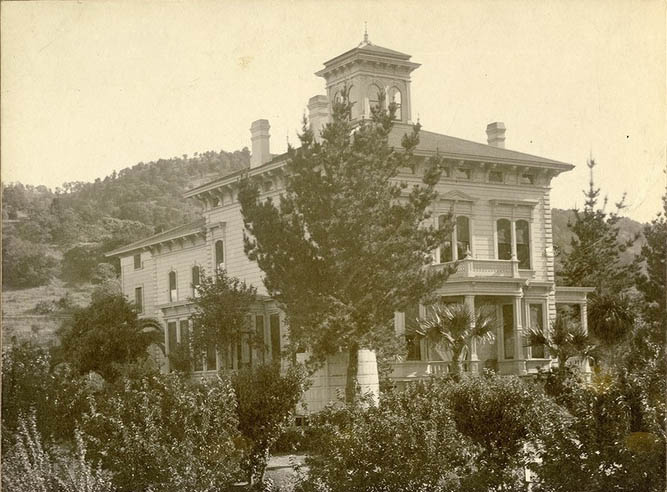John Muir Website Adds Page on Eliza Scidmore

John Muir c. 1872
Eliza Scidmore now has her own page on the John Muir website hosted by the Sierra Club.
The website, established in 1994, features a huge amount of information on all things Muir, with new material added regularly. After learning about Scidmore’s connection to Muir, the webmaster of the site, Harold Wood, invited me to post a page on Eliza Scidmore.
John Muir was a great inspiration to Scidmore in her own travels to Alaska in the 1880s.
Journeys of Discovery
Muir went to Alaska in 1879 and again in 1880 to pursue his interest in glaciers.
Arriving at Fort Wrangell for the first time, he met a young preacher, S. Hall Young, who shared his interest in nature. Muir hired several local Indians as guides and set off to explore southeastern Alaska by canoe. The 800-mile journey included paddling around the basin soon to be named Glacier Bay.
They lingered in the bay until October, when stormy weather forced them to head back to Fort Wrangell. As they hurried away, Muir glimpsed the magnificent glacier that would later be named for him. He returned a year later to study it.
Most Americans at the time knew nothing about Alaska, which the United States had purchased in 1867. Muir’s newspaper accounts of his Alaska travels attracted great interest, and he lectured to audiences on the West Coast.
Learning of Muir’s adventures, Eliza Scidmore decided to follow in his footsteps.
During her 1883 voyage, she and her fellow passengers aboard the mail steamer Idaho became the first tourists to visit Glacier Bay. (See my video and blog post describing that historic voyage.)
Scidmore repeated her trip the following summer. She turned her newspaper dispatches into the first book-length travelogue on the area, Alaska: Its Southern Coast and the Sitkan Archipelago (1885). She also published a comprehensive guidebook to Alaska in 1893.
Scidmore visited Muir and his wife at their fruit-growing ranch in Northern California.

John Muir home in Martinez, California. (Source: John Muir National Historic Site, NPS)
Father of Environmentalism
In the final decade of the 19th century, Muir emerged as the national figurehead of the burgeoning U.S. conservation movement. Scidmore advocated for the cause in some of her writings.
Muir had spent his 20s traveling widely — mostly on foot — and exploring wilderness areas. He famously spent a decade in Northern California’s Yosemite Valley and Sierra Nevada range. My First Summer in the Sierra, based on early journal entries, became one of his best-known works.
In the 1870s, Muir penned many articles about the value of nature and the need to preserve it.
A milestone occurred in 1890 when Muir published two articles in the Century, an influential magazine of the day.
Muir had met Robert Underwood Johnson, the Century‘s associate editor, in San Francisco in 1889. They embarked on a camping trip together to Muir’s beloved Yosemite Valley. Troubled by the area’s poor upkeep, they hatched the idea of lobbying to make Yosemite a national park. (Yellowstone was America’s only national park at the time.)
Muir’s articles in the Century helped spark broad support for the idea of wilderness protection. In the fall of 1890, soon after the articles ran, Congress made Yosemite a national park.
Forest Protection
The federal government went on to create a system of forest reserves in 1891 that put tracts of timber lands off limits from private logging and development. Eliza Scidmore described the new policy in a September 1893 article in the Century.
By then, she had been elected corresponding secretary of the National Geographic Society — the first woman elected to its board. She used her voice to advocate for conservation in alliance with Muir and others.
One of the most tangible results of Scidmore’s conservation advocacy was the designation of Mt. Rainier as a national park.
Muir and a group of supporters formed the Sierra Club in 1892 to help rally public support for wilderness protection in Northern California. Muir served as the organization’s president until his death in 1914.
Today the Sierra Club has 1.3 million members and supporters.
[…] So Scidmore boarded a steamship and headed north in 1883 and 1884 at a time when travel was not without considerable risk. The journeys were long and lasted for a month at a time, with few modern conveniences. Over the course of these trips, Scidmore visited Glacier Bay in Alaska and wrote the first extensive guidebooks about Alaska according to Parsell. […]